Nikki Haley’s Campaign Trail Style
What the Republican presidential candidate’s embrace of traditionally ‘feminine’ fashion means.

With her second-place finish in the New Hampshire presidential primary Tuesday night, Nikki Haley’s bid for the Republican nomination is all but over. The former South Carolina governor vowed in her concession speech to continue her campaign, looking ahead to the next round of votes in her home state. But the general consensus is that her path to beating Donald Trump is, at best, unclear.
Given that we have reached something of an unofficial end, I wanted to take a look back at Haley’s campaign trail fashion. Why? Well, for starters the presidential primaries hold a special place in my heart. As a reporter for the Wall Street Journal, I spent 14 months on the trail following then-candidates Mitt Romney and John McCain on the 2008 presidential campaign. The nomination contest is a particularly grueling sprint, racing from state to state in the depths of winter, convincing voters one handshake at a time.
Fashion on the primary campaign trail can be hard to come by, truth be told. My carry-on suitcase was filled with mostly black clothing so that everything would match. It goes without saying that candidates are expected to do more. And yet, most men stick to the dark suits, dress shirts, and ties we see the rest of the year. Any sense of style tends to come from the women in the race, with fashion offering both an opportunity and an additional burden. It’s a chore to get dressed in interesting outfits every day — but also the chance to stand out in the crowd.
The list of viable female candidates in recent cycles is depressingly short, with Hillary Clinton, Elizabeth Warren, and Kamala Harris. Now, Haley’s name joins that group and with a style all her own.
While I do not agree with Haley’s policy stances — I want to be clear here, I find them offensive and harmful — I think when a woman rises to the upper echelon of America’s political ranks with a specific style strategy, it is worth a look. She has notably veered away from the blend-with-the-boys strategy, instead wearing skirts, high heels, and statement sweaters. Below, some thoughts on how she has presented herself on the trail and what her choices say about the state of fashion for women in (or aspiring to) power.
PS: The latest episode of This American Life, called “Embrace the Suck,” has a segment on Democratic strategists campaigning for Haley in New Hampshire. It’s worth a listen.
So Many Thoughts on Nikki Haley’s Campaign Style
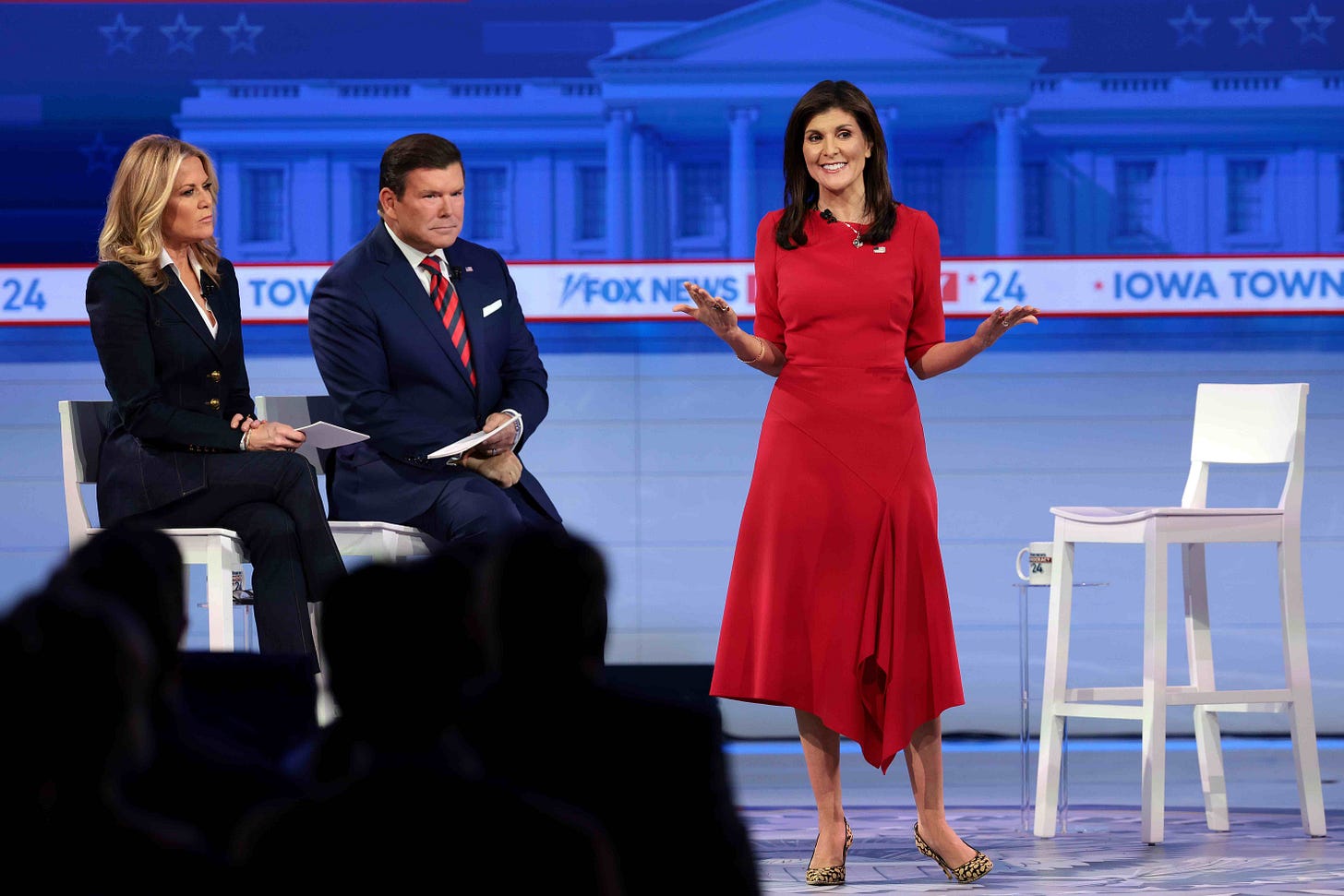
Before we dive in, I want to point out a crucial difference between political style, which we are about to discuss, and royal fashion, which we talk about all the time here at So Many Thoughts. Both offer an opportunity to present a public figure in a specific way, to further one’s work and craft a visual brand. The burden of presentation — and it does take more time, effort, and investment — is disproportionately placed on women, which is a separate (but very needed) conversation.
Royal fashion has a particularly heavy lift here because the wearers are seen much more than they are heard. This is true for most families, and particularly the Windsor women. They don’t tend to grant interviews very often (although that does seem to be changing). Their public remarks are limited to scripted speeches promoting a signature cause. What they do, far more often, is appear. Photographs of their engagements go around the world in seconds. Before we know what event they are attending or what charity they are visiting, we see what they are wearing. They use that to their benefit, sending messages through their choice of color, designer, and silhouettes.
People in politics, on the other hand, must use their voices — all the time. On the campaign trail, they never stop talking! And because of that, fashion takes on more of a supporting role. I would contend that what a candidate wears is still very important, reinforcing a stated sentiment or softening the delivery. There is an emotional response to what someone wears and a chance to connect with voters on a personal level. But clothes must be considered context of what is said.
So! Before we discuss her fashion, let’s answer the question…
Who is Nikki Haley?
The 52-year-old mother of two was born in South Carolina to Indian immigrants. Her parents owned a clothing store, which she began helping out with at the age of 13 (one can imagine she gained some interesting insights on fashion at an influential age, no?). Haley graduated from Clemson University, where she met her husband, Michael. He serves as a major in the National Guard and is currently deployed in Djibouti, Africa. “I would be lost without him,” she wrote in her 2012 memoir.
Haley began her political career in state politics before being elected governor twice. At the age of 38, she was both the youngest person to hold that office and the first occupant who was not a white man. Her national profile rose in 2015 when she signed a bill to remove the Confederate flag from the South Carolina House, a move she made following the mass shooting by a white man of Black parishioners at a Charleston church. She resigned from the governorship in January 2017 to serve as ambassador to the United Nations during the presidency of Donald Trump. (Her support and condemnation of Trump has swung back and forth over the years.)
In February 2023, Haley announced her run for president. More on her and her campaign from the Washington Post’s candidate series:
“Haley has rejected being defined by identity politics — whether having to do with her ethnicity or gender — calling that approach ‘woke self-loathing.’ She denies the existence of a glass ceiling despite running to put a ‘badass woman’ in the White House. She wants to talk in a ‘loving’ way about abortion rights, saying she can build a ‘consensus’ on the explosive issue (but is notably light on specifics).”
The New York Times has a summary of her sharply conservative stances on many issues, ranging from abortion (she supports a 15-week national ban) to transgender rights (which she views as “a threat to women”). Earlier this month, she said on Fox News the U.S. has “never been a racist country.”
Her very harsh takes notably seem at odds with her style…

Dresses? On a woman? Groundbreaking (really)
Let’s be honest: Female political candidate fashion here in America has long felt quite dull. It’s as if the women all decided that the best — or smartest? — sartorial strategy was to forgo style all together and do whatever they could to blend in with the men. Appease the patriarchy in pantsuits, if you will.
I was heartened by the movement toward more fashion in the 2016 campaign, with Hillary Clinton’s colorful, tailored, statement pieces (assisted by none other than Vogue’s Anna Wintour). Four years later, Elizabeth Warren had her Crayola-hued blazers, too. Kamala Harris’s vice presidential campaign style had a few particularly high moments, including the white pantsuit she wore when she joined Joe Biden in victory.
Haley’s campaign wardrobe this cycle has been a marked shift, an embrace of feminine styles that feels almost brazen. “Nikki Haley Wears the Skirts,” read the headline on Vanessa Friedman’s New York Times piece looking at the impact:
“Not just any old skirts: knee-length skirts. The kind of skirts often referred to as ‘demure,’ that suggest legs crossed at the ankle, and traditional gender roles. The irony is, in adopting this more classically female garment in this context, she looks both acceptably conservative and radical at the same time. After all, you’re not exactly fooling anyone in a pantsuit. So why not upend the status quo and wear something your rivals cannot?”
Haley’s fashion is similar to what she wore as governor, keeping her visual brand consistent. On the national stage, especially in the crowded early debates, it set her apart quickly and notably. Looking for someone who is not Trump? She’s right there, in a skirt.
On one hand, I must admit, I love to see this. Eschewing trousers feels like real progress, sartorially speaking. Haley’s fashion has interesting details, playing with fabrics and flourishes. Why must someone give up those styles to be seen as a serious contender in a campaign? Or any position of power? Why is it easier to dismiss someone in a dress? (Thanks, I hate it.)
On the other hand, Haley’s choices coupled with her extreme anti-everything policies call to mind the #TradWife movement. Have you heard about this slice of influencers? Rory Satran, in the Wall Street Journal, described it as “an online community of traditional women whose retro fashion reflects their religious, conservative and even sometimes far-right values.” The curled hair, red lips, and full skirts, Satran continued, are “straight out of I Love Lucy or Leave It to Beaver.” Which…is another vibe entirely. Taken that way, her fashion seems to soften the blow of her extreme positions.
Does one aspect of the aesthetic cancel out the other? I often think two things can be true but this one is hard to reconcile.
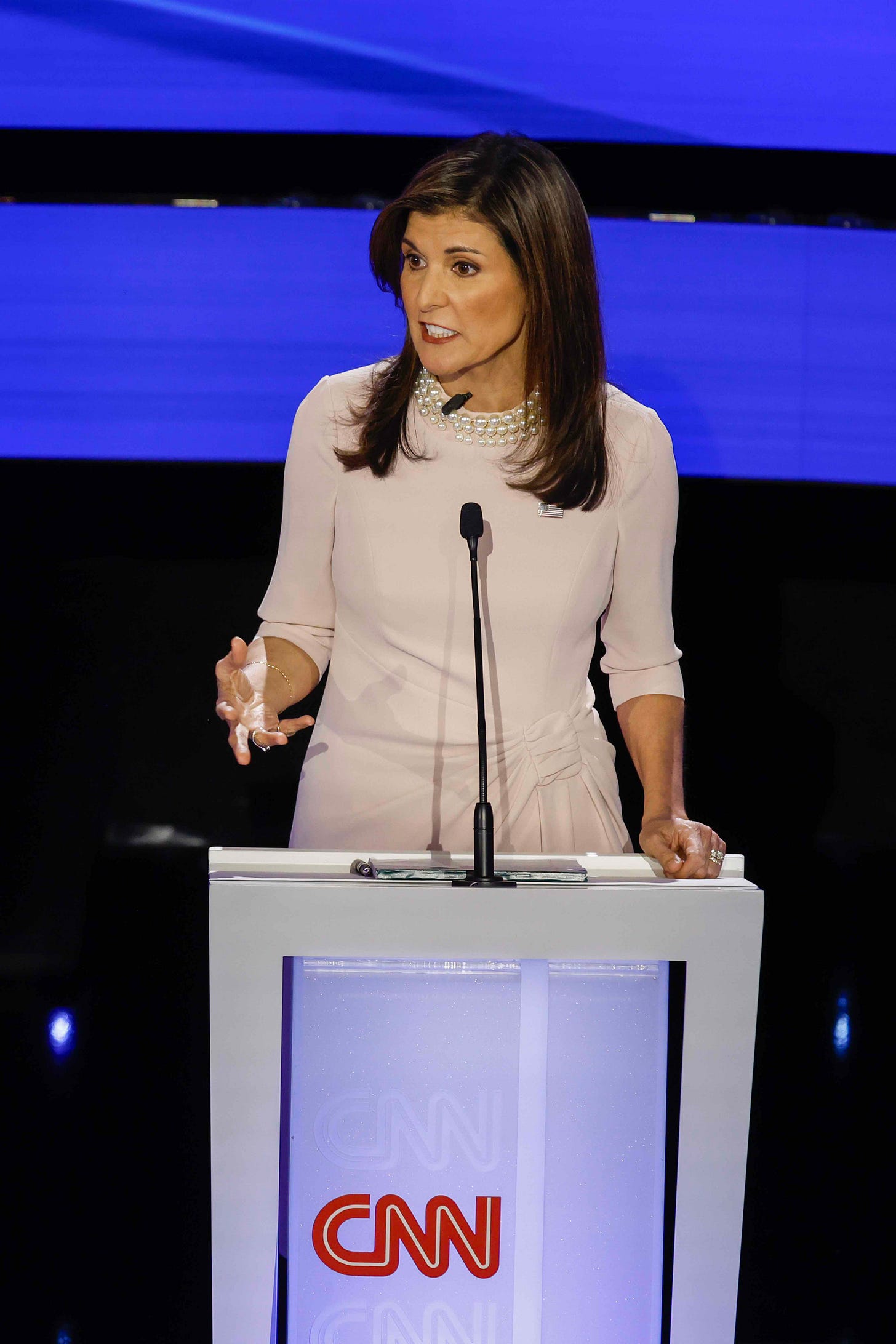
Choosing clothing carefully
What to wear when wooing voters is a tall order for any candidate, requiring a dance between accessible and aspirational (much like the royals). One must look relatable and down to earth, the kind of every-person voters in Iowa and New Hampshire would want to have a beer with, while also being worthy of the nation’s highest office.
This challenge is heightened for women, and even more so for women of color, says Keli Goff, who penned a guest column for the Hollywood Reporter. “Women of color must spend lots of energy achieving an appearance that will help us succeed at work, but even more importantly, will not hinder us,” Goff wrote. She pointed to Michelle Obama’s embrace of sheaths and sweater sets as a way to “soften her image and make her more relatable.” Goff described Haley’s Jan. 10 debate ensemble — a soft pink frock with three-quarter length sleeve and ruching at the hip, accessorized with three strands of large pearls — as “noteworthy to little girls who may like Barbie and aspire to be president someday, as well as adult women columnists who write about such things.”
I see another careful calculation in one of the designers Haley wears the most: Teri Jon. The New York-based brand, designed by Rickie Freeman, specializes in eveningwear and sells in department stores like Neiman Marcus and Saks. The aesthetic feels like old-school Oscar de la Renta, but the prices are just a fraction. “For women like you,” the brand’s website says. “Professionals. Mothers. Daughters. World travelers. Home-makers. Sisters. Partiers.”
Haley has worn Teri Jon for years, including a pale blush gown for her daughter’s wedding and a cherry red shirt dress when delivering her concession speech earlier this month in Iowa. The aforementioned soft pink dress? That was by Teri Jon (the pearls come with it).
She turned to the designer again this week, donning a Teri Jon navy blue metallic jacquard dress with a statement sleeve for her concession speech in New Hampshire. It coordinated perfectly with the backdrop of the evening, and caught the eye of former president Donald Trump. He said he watched her deliver her remarks “in a fancy dress that probably wasn’t so fancy.” He wasn’t wrong — and that’s probably why she wore it. The dress, with its $580 price tag, would be considered a splurge by many but not outrageous. To Republican voters concerned about the economy, it felt within the realm of acceptable.
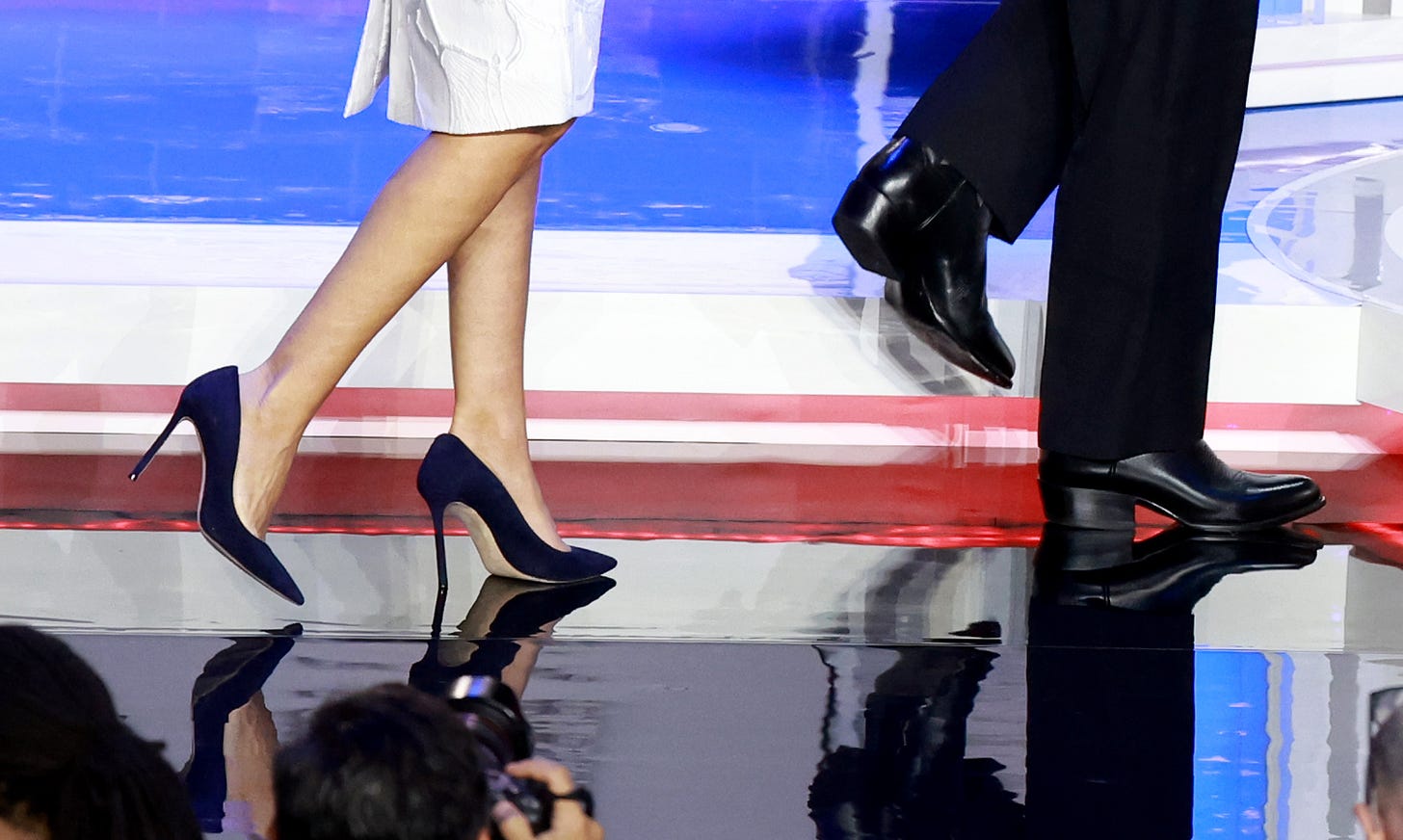
The sharp subtext of her stilettos
And then there are the shoes! Let’s talk about her heels. But first, a bit of context from my time on the trail. A presidential candidate loves nothing more than a quick, scripted quip, one that they can repeat at campaign stops all around the country. It’s a lasting soundbite, something that feels pithy but actually has real power, with the potential to win over voters.
One of Haley’s lines is about her stilettos, which she repeated on the debate stage last November. When then-candidate Vivek Ramaswamy questioned Haley’s choice of “three-inch heels” in a debate, she was ready. “I’d first like to say, they’re five-inch heels, and I don’t wear ’em unless you can run in ’em,” she said with a smile. “The second thing I will say is: I wear heels. They’re not for a fashion statement; they’re for ammunition.”
Haley has used that framing — weaponizing her stilettos — for years. In the video announcing her campaign for presidency, she referenced looming threats from China and Russia. “They all think we can be bullied, kicked around,” she said. “I don’t put up with bullies. And when you kick back, it hurts them more if you are wearing heels.”
My first thought was: We’re still doing this? We’re still using fashion as a clapback with #girlboss energy? Rachel Tashjian wrote about the positioning of Haley’s heels in the Washington Post:
“High heels are a familiar tool for those who want to use the double standard of femininity against itself: They are painful but a source of pleasure, intentionally difficult to walk in and therefore a source of power if you can wear them with ease or for long periods of time…As the necktie has remained a part of the male political uniform (all the candidates, even self-proclaimed disrupters like Ramaswamy, wear them), the high heel has gone out of fashion in most professional settings,” Tashjian wrote. “So her commitment to them says something. Regardless of where you sit on the political spectrum, Haley seems to see her commitment to five-inch heels as an act of endurance, a testament to her stamina.”
Perhaps that’s why Haley emphasized her heels in big campaign moments. Unlike trousers, which can conceal most of a shoe, skirts put them on full display. In the November debate when she made her ammunition quip, she styled her white skirt suit with navy pumps. The choice stood out a lot more than, say, tan. Earlier this month, at a televised town hall with Fox News, Haley chose a bright red dress and patterned heels that looked almost leopard-print like. (She was seated on stage, not behind a podium, meaning the heels were on prominent display.)
Consider how different this discussion feels from Harris and her choice of Converse sneakers. Once again, I AM TORN. I love a great heel and the way it can make you feel. And I absolutely want women in positions of power to wear them if and when they want to. But I could do without Haley’s wink-wink implied violence, thankyouverymuch.
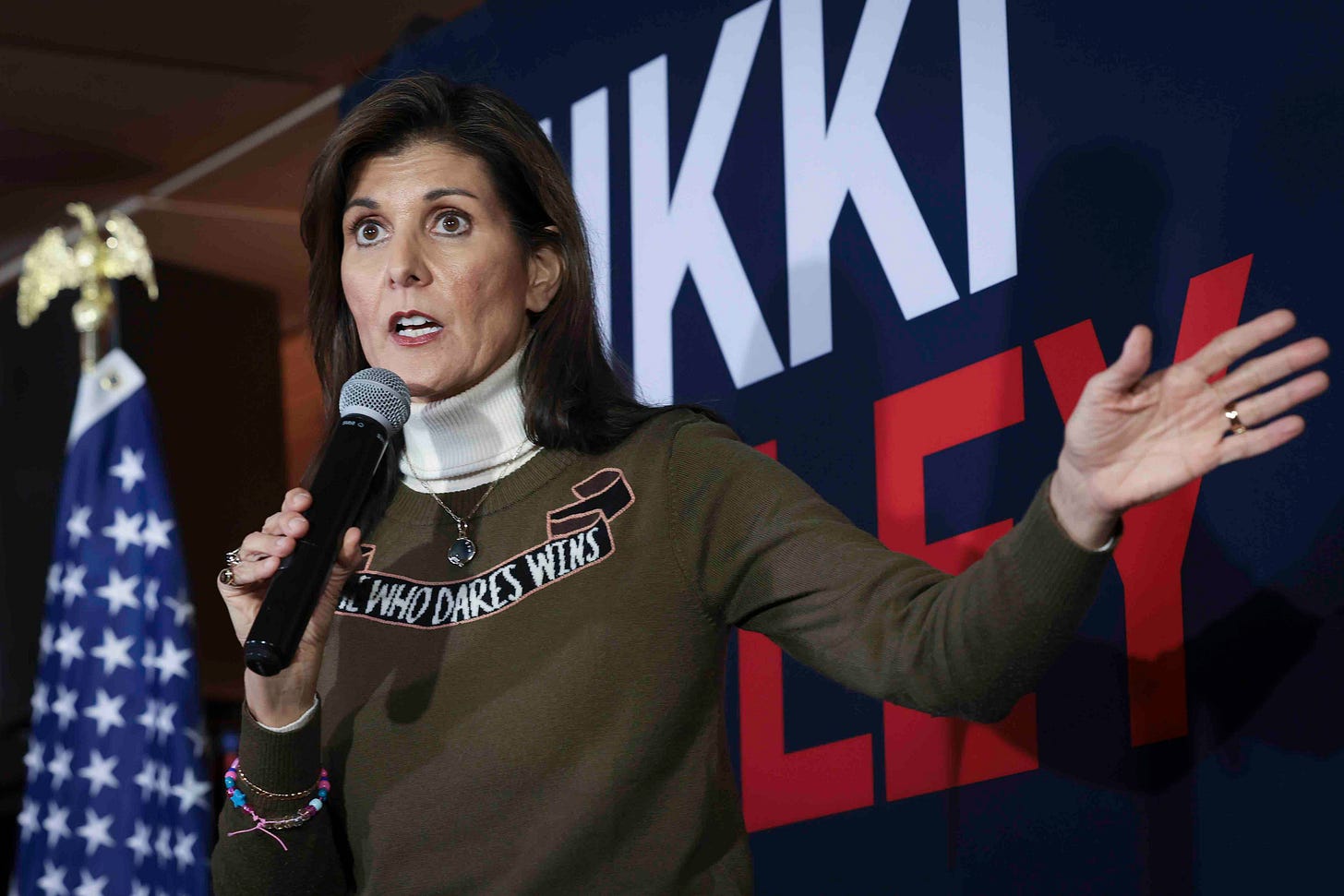
The soft spin of her sweaters
In the run-up to the caucus in Iowa and the primary in New Hampshire, Haley introduced yet another new-to-the-trail style: the statement sweater. Mattie Kahn reached out to talk to me about these knits — you can read more in her great piece for Vogue.com. So many thoughts on this aspect of Haley’s wardrobe alone. She has worn them often, everything from a classic cable knit to much kitschier styles.
Thanks to their designs, these pieces maintain the visual differentiation for Haley. Take the two Ralph Lauren sweaters with flags emblazoned across the entirety of the top. It’s as if someone took the flag pin off a suit lapel and supersized it. (As I always say, fashion messaging is best, especially in a non-fashion forum like politics, when it’s obvious.)
There was also a deep brownish-green sweater by Temperley, which quickly made headlines thanks to the all-caps words flying high: “SHE WHO DARES WINS.” The Daily Mail ran a piece about the knit, pointing out designer Alice Temperley’s pro-Palestinian social media posts. My guess is that voters in these primary states probably didn’t know who made the sweater and were very unlikely to connect it with what the British designer said on the internet. They saw it in the most obvious way possible, as a woman asserting herself. (As an aside: You can spot a friendship bracelet in the above shot of Haley. She said that “so many little girls” had given them to her during the campaign.)
Perhaps most importantly, style specifics aside, the idea of a sweater is relatable. What does every woman in Iowa or New Hampshire wear in the winter? A sweater. (I say this with confidence having grown up in the midwest). It’s a wardrobe staple, and for good reason. There is a literal warmth to the style, a softness to the yarn and still a hint of sturdiness to the shape.
As I told Kahn for Vogue.com, there have to be logistical benefits, too — you know I love when fashion has to function. Lots of primary campaigning happens in states with sub zero temperatures. And, at this point in the race, when the whole Haley operation is likely running on fumes (the final stretch is grueling), it’s far easier to shake out a sweater than steam a dress. My verdict on the sweaters: A win-win.
As I’ve said throughout the newsletter, I am conflicted on Haley’s style when considered with her policy stances. There is a tension there that does not sit right with me. But I do hope that her willingness to depart from the dark-suit norm will be seen as something of a step forward. And perhaps future candidates — if they are so inclined — will feel comfortable embracing fashion more freely.
What do you make of Haley’s campaign trail fashion? I would love to hear your thoughts! Click below to share in the comments.

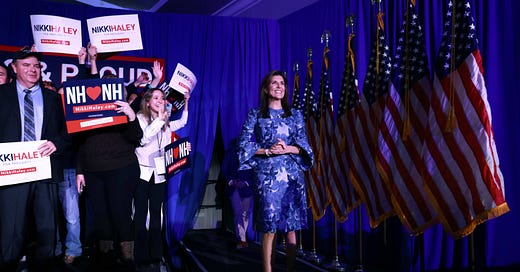





I appreciate your insight and you clearly stated that you do not agree with her politics. I have to say that I find this coverage refreshing. Taking the politics away I think it is remarkable what this woman has accomplished. Just like we say to believe all women we should also be able to appreciate all accomplishments women have made in general. Condolezza Rice is another woman I find interesting for everything she overcame. I do not think you legitimize her any less than a Royal Family member who could also be petty horrible. I am concerned about cancel culture and not being able to appreciate what a woman has accomplished even when I do not agree with her politics. You are a journalist and journalists report on the topic and the assignment and don’t input their own agenda. Thank you for being you and for teaching me, I find your Substack encouraging and I do not feel as I am the only one thinking these things or being afraid to say I may be interested in her clothing despite the harsh messages. You covered the First Lady so now you covered Haley. Seems like fashion journalism to me. Thank you Elizabeth!
I loved reading this. It’s a great study of how women/people use clothes as part of their messaging strategy, which as you’ve said before is kind of the whole purpose of SMT. This is the content I’m here for!